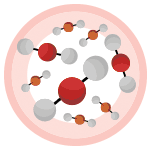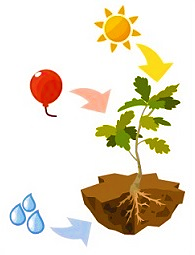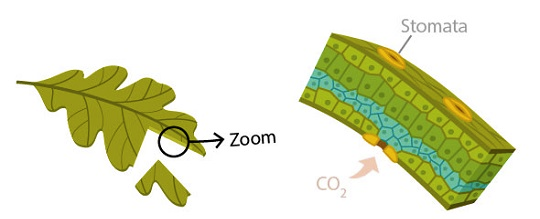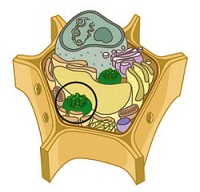show/hide words to know
Carbon dioxide: a chemical compound (a gas) that has two oxygen atoms and one carbon atom (CO2); carbon dioxide is a greenhouse gas... more
Chlorophyll: the pigment that gives plants their green color and allows them to absorb sunlight... more
Chloroplast: a part of a cell found in plants that converts light energy into energy plants can use (sugar). Other living organisms such as algae also have cells that contain chloroplasts.
Element: in chemistry a substance that cannot be broken down (separated) by a chemical process... more
Mass: is used to describe how much matter is in an object. If you know the number of atoms, the density of the atoms, and what type of atoms are in an object you can calculate its mass.
Oxygen: an element that makes up about 21% of air and that many organisms need to live.
Photosynthesis: a set of chain reactions that convert light energy into chemical energy. Photosynthesis also produces energy-rich carbohydrates like starch. Photosynthesis occurs in the chloroplast of a plant cell... more
Where Does a Plant's Mass Come From?
Have you ever wondered where plants get their mass? All those leaves and branches have to come from somewhere, but where? It turns out that the main ingredients for plant growth are water, air, and energy.

Where plants get their mass.
The Story of Air

The molecule carbon dioxide is made of one carbon atom and two oxygen atoms.
The air around you may seem empty, but it's not.
Air is made of tiny bits that we call molecules. If you had enough air molecules, you could even weigh them.
Two of the molecules in air are oxygen and carbon dioxide. You may think oxygen is the most important molecule—we need it to live. But carbon is important too. All living things on Earth are made of carbon.
If you removed the water from our bodies, you would find that carbon makes up most of the rest of our weight, or mass. The same is true for plants.

Plants don't get carbon from any of these sources.
We get carbon from our food, but where do you think plants get carbon? They don't get their carbon from the soil, or from the sun, or from water.
Plants pull carbon out of the air.
Are Plants Made from Thin Air?

Plants need energy from the sun, water from the soil, and carbon from the air to grow.
Air is mostly made of nitrogen, oxygen, and carbon dioxide. So how do plants get the carbon they need to grow? They absorb carbon dioxide from the air. This carbon makes up most of the building materials that plants use to build new leaves, stems, and roots. The oxygen used to build glucose molecules is also from carbon dioxide.
Water is another important material plants need to grow, and they get it by absorbing it through their roots. Water is made of two hydrogen atoms and one oxygen atom. The hydrogen in water is used to help build glucose molecules.
A plant can be up to 95% water. Think of the water as the filler they use between carbon structures. If we take away the water from a plant though, and look at just the dry material, a large majority of that material comes from thin air.
Plants also need tiny bits of vitamins and minerals to grow properly, which they get through their roots.
Plants need a lot of energy to take care of their cells and to build new ones so they can grow. Plants get their energy from the sun.
The Carbon Story

Plants absorb carbon dioxide through small openings called stomata that are on the surface of the leaf.
If we zoom in on a plant leaf, so close that we can see the cells, we'll find tiny openings called stomata. Stomata are holes made from spaces between special cells. These holes are where plants absorb carbon dioxide from the air.
Once inside the leaf, the carbon dioxide can enter plant cells. Inside the plant cells are special cell parts called chloroplasts, where photosynthesis takes place.

Circled inside the plant cell is one of hundreds of chloroplasts that live within the cell.
Plant cells look green due to molecules in the chloroplasts that reflect green light. There are many, many chloroplasts in every green plant cell. Most of the rest of the cell usually looks clear.
In the chloroplasts, carbon, oxygen, hydrogen, and energy are used to make a sugar called glucose. The whole process of making glucose is called photosynthesis.

Molecules of glucose join together to form cellulose.
Next, glucose molecules combine to form long chains called cellulose. Cellulose is then used to build plant structures, like cell walls.

As more cells divide, the plant's leaves, stems, and roots can grow larger.
These structures and the materials they hold are also built with water.
When new cell structures are built, cells can grow and divide, making new cells. These new cells make for new plant growth. This lets the plants get bigger.
So if you are creating a cookbook of life and want to include a recipe for plant growth you would add the following.
- Water, which can make up to 95% of the weight of a plant, enters the plant through its roots.
- Carbon, which makes up the most of the rest of the plant, comes from the air and enters the plant through holes in its leaves.
- Oxygen from carbon dioxide, and hydrogen from water, enter through the leaves and roots, and are used to make glucose.
- Energy, which the plant needs for photosynthesis to work, is absorbed from sunlight.
This section was contributed by Karla Moeller and Charles Kazilek. Images are by Sabine Deviche.
View Citation
Bibliographic details:
- Article: The Recipe for Plant Growth
- Author(s): Heather Kropp, Angela Halasey
- Publisher: Arizona State University School of Life Sciences Ask A Biologist
- Site name: ASU - Ask A Biologist
- Date published: February 5, 2015
- Date accessed: April 17, 2024
- Link: https://askabiologist.asu.edu/recipe-plant-growth
APA Style
Heather Kropp, Angela Halasey. (2015, February 05). The Recipe for Plant Growth. ASU - Ask A Biologist. Retrieved April 17, 2024 from https://askabiologist.asu.edu/recipe-plant-growth
Chicago Manual of Style
Heather Kropp, Angela Halasey. "The Recipe for Plant Growth". ASU - Ask A Biologist. 05 February, 2015. https://askabiologist.asu.edu/recipe-plant-growth
Heather Kropp, Angela Halasey. "The Recipe for Plant Growth". ASU - Ask A Biologist. 05 Feb 2015. ASU - Ask A Biologist, Web. 17 Apr 2024. https://askabiologist.asu.edu/recipe-plant-growth
MLA 2017 Style

Check out our printable poster of the full carbon story.
Be Part of
Ask A Biologist
By volunteering, or simply sending us feedback on the site. Scientists, teachers, writers, illustrators, and translators are all important to the program. If you are interested in helping with the website we have a Volunteers page to get the process started.








